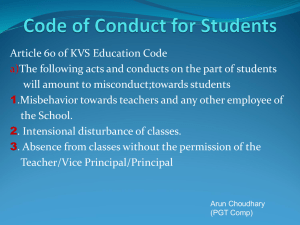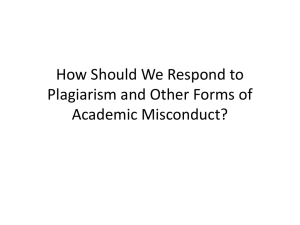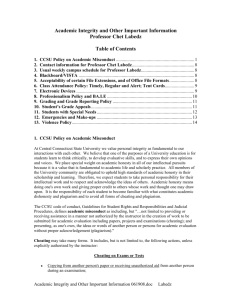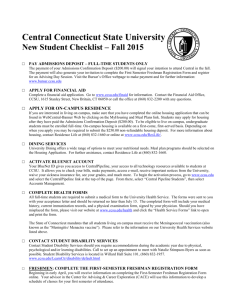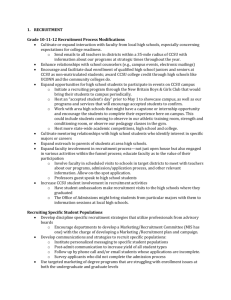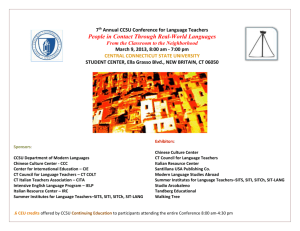Academic Integrity Presentation Lesson Faculty Presentation Option
advertisement
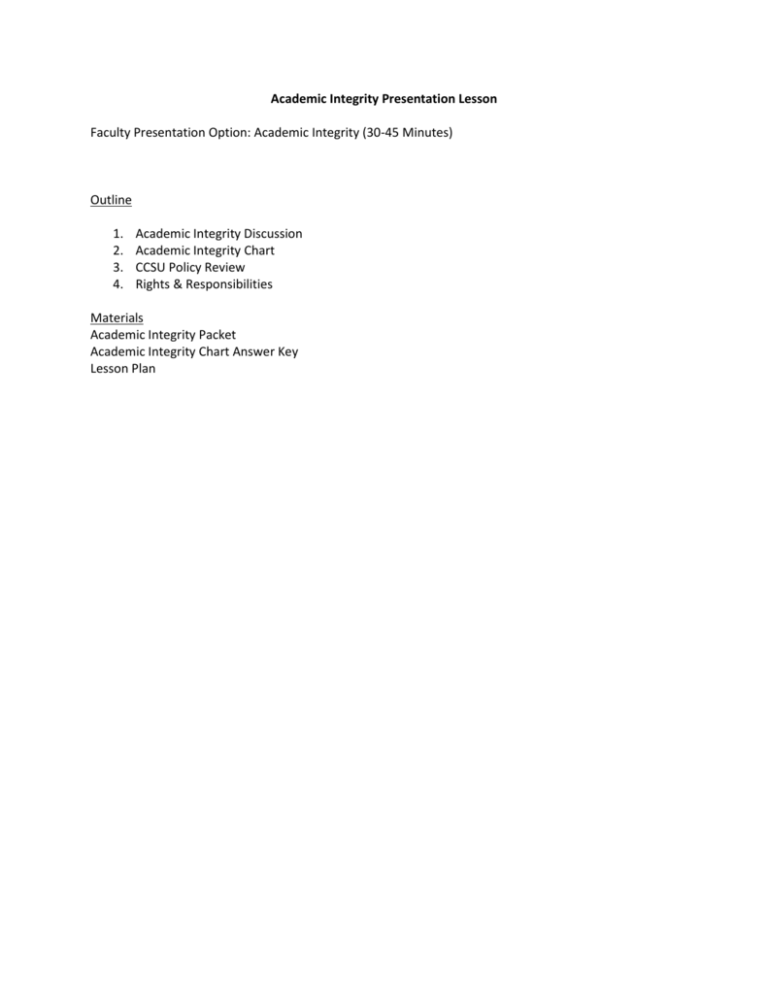
Academic Integrity Presentation Lesson Faculty Presentation Option: Academic Integrity (30-45 Minutes) Outline 1. 2. 3. 4. Academic Integrity Discussion Academic Integrity Chart CCSU Policy Review Rights & Responsibilities Materials Academic Integrity Packet Academic Integrity Chart Answer Key Lesson Plan Activity 1: Academic Integrity Discussion (5-10 Minutes) Purpose: To have students understand what constitutes academic misconduct and what the value is of academic integrity. Directions: 1. Let the students know that today they will be having a discussion about academic integrity. (1 minute) 2. Ask the students a question (Allow multiple responses-if the students are having difficulty, prompt but do not give the answer). (2-3 Minutes) a. Question: What does it mean for a person to have integrity? 3. Bring up some events from the past five years that have been in the news, pop culture, that have brought people’s integrity to the forefront. (2-3 Minutes) a. (Examples: Think of some current examples before you present-ie. Tiger Woods) b. Question: How do you think academic integrity relates to the academic world & why is it important? 4. Let the students know that integrity is an important topic to discuss and it relates to the academic world in the form of academic integrity. (2-3 Minutes) a. Question: What do you think the definition of academic integrity is? Modification Option: To make this section shorter: You can spend less time discussing the two questions and just elicit responses from 2-3 individual students Activity 2: Academic Integrity Chart (20-30 Minutes) Purpose: To determine what students know about academic integrity. Option 1: Academic Integrity Chart with a Partner (Longer Version-30 Minutes) 1. Complete the Academic Integrity Chart (15 Minutes) a. Have the students turn to the front page of the packet, the Academic Integrity Chart b. Have the students find a partner they would like to work with c. Tell the students to discuss the questions with their partner. They should do the following: (15 Minutes) i. Write down their initial assumption of the answers ii. Look through the packet to find proof of the real answers and write this on the chart (paragraph/page #) iii. Write down the CCSU policy answer (true or false) (Allow the students to work on this for a few minutes and walk around the room while they are completing it to make sure that students are on the right track. Check in and let them know how much time they have left to complete the chart) 2. Review the chart (15 Minutes) a. Go through each question separately and discuss b. Ask the students how many of them wrote down true or false and elicit some answers as to why i. You can say “Ok, it seems as if everyone has finished. Who would like to read the first statement?” (Have a student read the statement) “For those of you who did not have to answer this question, how many of you think this is false? How many of you think that it is true”? (Have the students raise their hand to indicate) “Why did you write true or false?” c. Clarify what the answers are regarding the policy and have students add to their chart as you discuss Option 2: Academic Integrity Chart in a Group (Shorter Version-20 Minutes) 1. Complete the Academic Integrity Chart (10 Minutes) a. Divide the students into small groups and tell them to assign a spokesperson b. Have the small groups determine what their initial assumption of the answers are c. Then let the groups know that they will be in a race to find the most correct answers in the packet. Explain the directions to the class: “The group with the most correct answers in five minutes will be the winner of this race. Look in your packet to determine what you believe the correct answers are. Then we will write down evidence of where to find the answer to the policy in the packet together.” d. Divide the questions evenly between groups (there are seven questions) e. Give the groups five minutes to determine true or false f. At the end of five minutes, look at the answers on the spokespersons paper and determine which group had the most answers correct (Allow for the students to work on this for a few minutes and walk around the room while they are completing it. Check in every few minutes to let them know how much time they have to complete the chart.) 3. Review the chart (10 Minutes) a. Go through each question separately and discuss b. Ask the students how many of them wrote down true or false and elicit some answers as to why i. You can say “Ok, it seems as if everyone has finished. Who would like to read the first statement?” (Have a student read the statement) “For those of you who did not have to answer this question, how many of you think this is false? How many of you think that it is true”? (Have the students raise their hand to indicate) “Why did you write true or false?” c. Clarify what the answers are regarding the policy and have students add to their chart as you discuss (They can write down the page number and paragraph as you discuss each question) Modification Option: To make this section longer: Choose option one. You may also want to spend more time discussing each of the answers to the questions. To make this section shorter: Choose option two. You can spend less time discussing the answers to each of the questions. You can have students raise their hand to indicate what they came up with and then you can provide the information for them to write on the chart. Activity 3: Policy Discussion (5 Minutes) Purpose: To give students a better understanding of the specific details of the academic honesty policy 1. Now that the students have taken the quiz and have found some answers to policies at CCSU, go over any parts of the policy that were not discussed a. RE-iterate the importance of academic integrity. “Academic Integrity is at the core of your learning at CCSU. These policies are designed for you to have the greatest intellectual gains from your academic experience. Cheating robs you of an opportunity to learn.” b. Discuss plagiarism Modification Option: To make this section longer: Have students read specific portions of the packet out loud to add to their knowledge of academic integrity and the coinciding policy. To make this section shorter: You can quickly summarize anything that was not covered in the quiz Activity 4: Rights & Responsibilities (5-20 Minutes) Purpose: To give students a clear understanding of what constitutes cheating, the consequences of cheating and the appeals to grade change policy at CCSU. Option 1: Quick Review of Rights & Responsibilities (Shorter Version-5 Minutes) 1. Have the students turn to the Rights & Responsibilities page in the packet 2. Have three students volunteer to read the three Rights & Responsibilities aloud. 3. Discuss each briefly by asking a question to the class. a. Question: what is important for you to know about these Rights & Responsibilities? Option 2: Group Presentation of Rights & Responsibilities (Longer Version-20 Minutes) 1. Have the students count off by 3’s all around the room 2. Have the students separate into groups based on their # 3. Have the students turn to the Rights & Responsibilities Page a. Group One: Right to Freedom of Expression b. Group Two: Right to Adequate Instruction c. Group Three: Right to Proper Academic Evaluation 4. The students will be doing a group presentation based on the following outline (write on the board) a. Explanation of the “right” described. b. Explanation of the student “responsibility” described. c. Create your own example of a violation of the “right” and describe the process a student should follow to resolve the conflict. d. Create your own example of a student violating his/her “responsibility” and describe the potential consequences of this violation. (Give the students around ten minutes to prepare for their presentation. Then each group will have about 2-3 minutes to present and will need to teach the class what the right or responsibility is. Walk around the room to monitor the student’s progress.) 5. Have each group present the outline that they came up with. a. (After each presentation, you may want to clarify the main ideas and give each group some positive feedback) Modification Option: To make this section longer: Choose option 2 To make this section shorter: Choose option 1 Academic Integrity Chart: Answer Key Question 1. You are taking an exam in your psychology course and you realize that the person next to you is looking over your shoulder and copying your answers. You are not guilty of academic misconduct, but the person copying your paper is! Evidence from the Packet (Page # & Paragraph) 2. You wrote a 5-page paper arguing against an issue in your political science class. Your composition professor assigns the same kind of paper three weeks later. The composition paper can be no more than 3 pages long. You edit the political science paper and hand it in. This is a form of cheating. 3. Your professor discovers that you have not acknowledged the source of some information you included in your paper. You could receive an “F” in the course for plagiarizing. CCSU Policy True/False False “Knowingly allowing another person to copy from one’s paper during an examination” (P. 3; 1C) Key word is “knowingly allowing” What can you do about it? Cover your paper, move your seat, or tell the professor. “Submission of the same work, True or substantially similar work, in more than one course without P.4; 2F prior consent of the evaluating instructor(s)” (P. 4; 2F) (Many students may bring up how you won’t get caught – but integrity isn’t necessarily about getting caught, it’s about your actions and what you do.) Question: Why are papers/assignments given to students? (To practice research/other skills, make you learn more, expand your knowledge) – how does handing in the same paper accomplish this? “Copying sentences, phrases, paragraphs, tables, figures or data directly or in slightly modified form from a book, article, or other academic source without using quotation marks or giving proper acknowledgment to the original author or source.” (p.4; 4A) Why do we cite sources? There are three main reasons: 1. To give credit where it is due. 2. To give the reader (professor) another resource to gather True P.4; 4A information about an idea or topic written about. 3. Gives the paper “weight” or credibility. The more sources to back up the writer’s theories, the more legitimate the theory appears. 4. You state, in your own words, information you found while researching your paper. You list the source in your bibliography. This is plagiarism. 5. You have a lively discussion with a friend about an issue raised in your philosophy class. He has the same class, with the same professor, at a different time of day. You both hand in a paper on the topic and your friend uses your conclusions and your supporting arguments. He is guilty of cheating. 6. You can be expelled from the University if you are found guilty of academic misconduct. “By précis; condensing part of a writer's argument.” (P. 4; 4A) You must also cite information in the BODY of the paper and not simply the bibliography. Three ways to put information from another source into your paper is direct quote, and précis (summarizing) or paraphrasing (to keep the flow of the paper, putting the information in your own words). All three ways must still be cited within the text – P. 4 How to Understand Plagiarism True “Unauthorized collaboration in the preparation of materials to be submitted for academic evaluation; e.g., working with another student on an assignment when the instructor has not authorized working together” (P. 4; 2E) True Unless a professor says you can work on an assignment together, you are not supposed to. Although today, students are encouraged to work in groups – it is all about keeping the line of communication open with the professor. “Upon determination by the Office of Student Conduct that the Accused Student has no prior record of academic P.4; 4A; How to Avoid Plagiarism ii. P.4; 2E True P.5; 2A misconduct, the Student will be required to attend an Academic Integrity Workshop provided by the Learning Center. If the Accused Student has a prior record of academic misconduct or has engaged in a severe act of misconduct, she or he may face disciplinary sanctions as determined the Faculty Hearing Board. The Faculty Hearing Board may impose one or more of the following disciplinary sanctions: disciplinary probation, suspension, or expulsion from the university.” (P. 5; 2A) 7. You feel your teacher has given you a lower grade than you earned because of a disagreement you had during the semester. There’s nothing you can do about this. This is the highest sanction for academic misconduct at the university. All penalties are at the discretion of the judicial officer and each case is taken on an individual basis There is a grade appeals process (P. 5; 1B) that begins the professor (there may be a valid reason why the student has been given the lower grade & it is not because of the disagreement), then moves up to the department head/chair, dean of the college and then the grade appeals review board whose decision is final. It is a long and tedious process and the student must PROVE they are worthy of the higher grade. False Page 5 1B & Page 6


